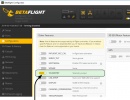Cypher/Telemetry
From Flex Innovations Wiki
Contents
Available Telemetry Settings (Optional)
- Telemetry can be very useful for the FV-31 Cypher. You can get the most out of your battery by:
- Monitoring the flight pack voltage and set voltage alerts
- One way (preferred by most Flex Pilots) is to set a flight pack voltage alarm of approximately 10.2V
- Program transmitter to alarm WHILE the voltage is below that voltage, and to not alarm if the voltage recovers higher than the threshold.
- While flying, the alarm may sound at times under high loads. Monitor this, but keep flying.
- If the alarm is on during steady hover, steady forward flight, or more than 30% of the time, land as soon as possible!
- An alternate way is to set a lower flight pack voltage alert (9.1V for example) and plan to land the first time it is hit.
- This way may be less reliable due to high momentary loads.
- May trigger early with 'weaker' battery packs.
- One way (preferred by most Flex Pilots) is to set a flight pack voltage alarm of approximately 10.2V
- Calibrate and monitor you flight pack capacity used and set capacity alerts.
- Best if you fly all packs of the same or very similar size
- Set a transmitter alarm once a specified capacity is reached.
- Monitoring the flight pack voltage and set voltage alerts
- NOTE: The user should always make conservative first flight with a timer, and be conservative. Monitor the 're-charge' capacity of the packs, and the telemetry indications and fine tune their best use based on their preferences.
Spektrum Telemetry
- These instructions supplement the non-telemetry setup instructions in the Cypher manual.
- Easy to setup (really just the third pin plug and telemetry slider in configurator) and provides the following Telemetry Data:
- Provided by Rx:
- Fades (frames lost by individual sub-Rx)
- Frames (frames of data lost buy all combined Rx)
- Holds (Failsafe caused buy more than 40 continuous Frame losses)
- Some may provide Rx bus (BEC) voltage, SPM4649T appears to not provide it
- Provided by Betaflight/FLEXF3:
- Main Battery Pack (Main 3S) Voltage
- Virtual (estimated) Current
- Virtual (estimated) Capacity used (fuel totalizer)
- Provided by Rx:
- Choose a telemetry capable receiver such as the SPM4649T (Preferred) or AR8010T
- Bind the receiver to the transmitter
- Connect to FLEXF3 using the first 3 pins (-,+,signal). (Use 3-male to 3-mail pin cable if required for AR8010T style receivers)
- Use your configuration tool to: (hit the pages 'Save' button before leavng each page)
- On Configuration page
- Make sure Receiver Mode is set to a serial based receiver.
- Make sure Serial Receiver Provider is set to SPEKTRUM2040/SRXL
- Now in Other Features, set the TELEMETRY slider to ON.
- On the Receiver page, make sure your Channel Map is set to TAER1234 (SPEKTRUM)
- On Configuration page
- You should now have Telemetry, and you can use your transmitters instructions and settings to display and alarm as desired.
Futaba Telemetry
- These instructions supplement the non-telemetry setup instructions in the Cypher manual.
- Only Telemetry provided by the Rx is available. Receivers are available that can sample Main Flight Pack Voltage.
- Betaflight/FLEXF3 Data not available, so no Betaflight settings are made.
- To connect the Receiver's telemetry to the Cypher's flight pack voltage tap:
- Choose an S.Bus capable receiver (T-FHSS, FASSTest) that provides Telemetry and has a Voltage port (XXX, R7008SB FASSTest)
- "Y" or "Split" the small cable that provides Voltage Data to the FLEXF3. Install the Futaba compatible Voltage Cable/Plug to the voltage cable. (check polarity carefully!)
- Plug the voltage cable into the receiver
- Follow the Futaba instruction to configure the Futaba equipment to display/alert with telemetry
Jeti Telemetry
- These instructions supplement the non-telemetry setup instructions in the Cypher manual.
- Powerful, but requires custom made cable.
- Provided by Rx:
- Radio Signal Data
- Receiver bus voltage (BEC)
- Provided by Betaflight/FLEXF3:
- Main Battery Pack (Main 3S) Voltage
- Virtual (estimated) Current
- Virtual (estimated) Capacity used (fuel totalizer)
- Horizon Angle in Pitch and Roll
- Provided by Rx:
- Choose a telemetry capable receiver such as the EX R3
- Bind the receiver to the transmitter
- Fabricate the Custom 3-pin to 4-pin male -to- male cable. (You can use the supplied two cables for parts)
- Remove insulation from the middle of the 'signal' wire.
- 'Y' the wire and install a 2.2k Ohm resistor as shown in image at right.
- Insulate with heat shrink tubing.
- Connect to FLEXF3 using the first 3 pins (-,+,signal) at the Rx's EX Bus Port and 4-pins at the FLEXF3 (-,+,Rx,Tx)
- Use your configuration tool to: (hit the pages 'Save' button before leaving each page)
- On Configuration page
- Make sure Receiver Mode is set to a serial based receiver.
- Now set the Serial Receiver Provider to JETIEXBUS
- Now in Other Features, set the TELEMETRY slider to ON.
- On the Receiver page, make sure your Channel Map is set to TAER1234 (SPEKTRUM)
- On Configuration page
- You should now have Telemetry, and you can use your transmitters instructions and settings to display and alarm as desired.
Here is an External Link to Betaflights Telemetry information.
NOTE: For reference only. Not all features are supported by the FLEXF3 (see Above)
Cypher Wiki Main

